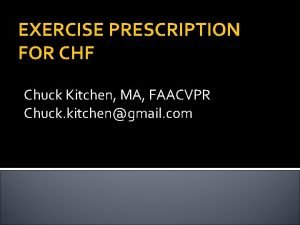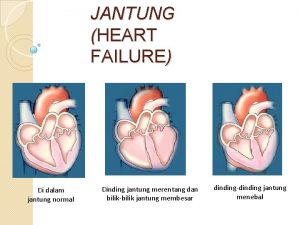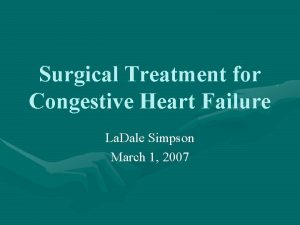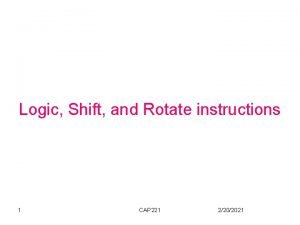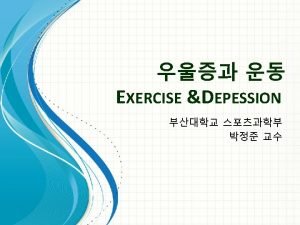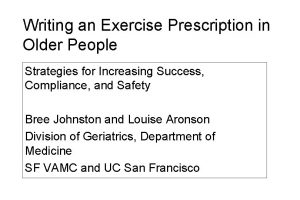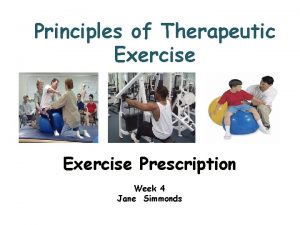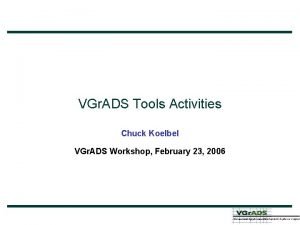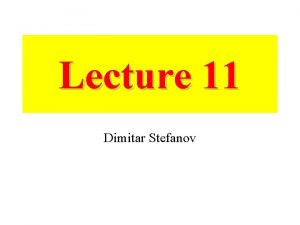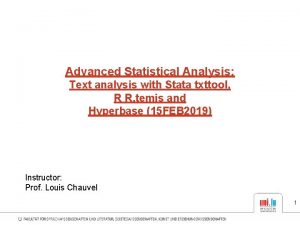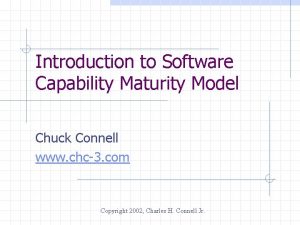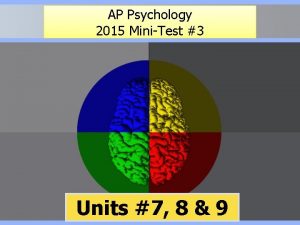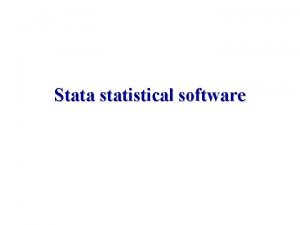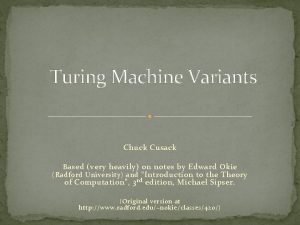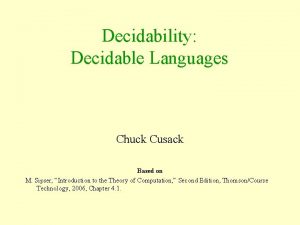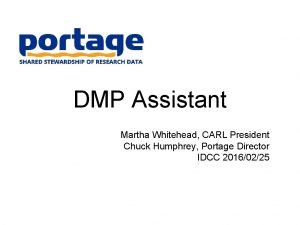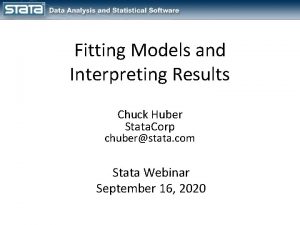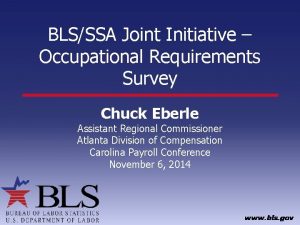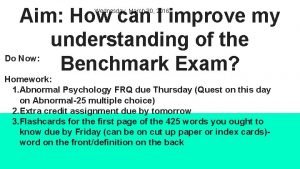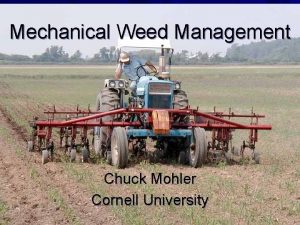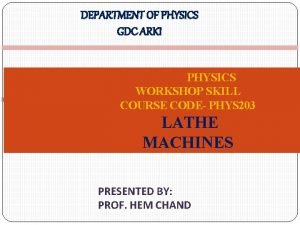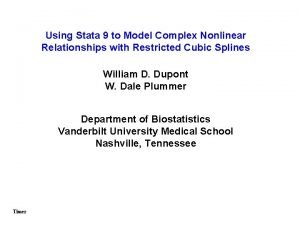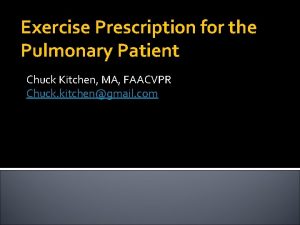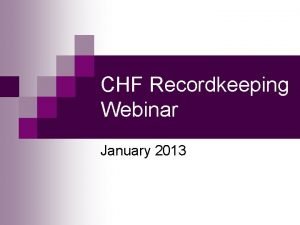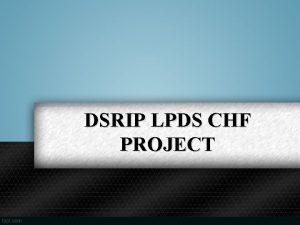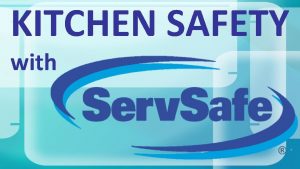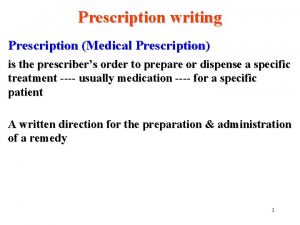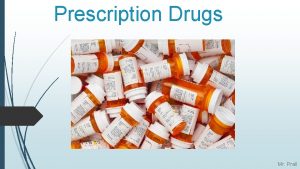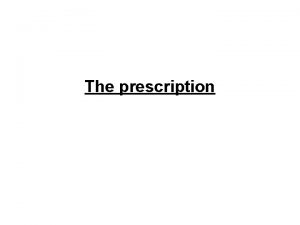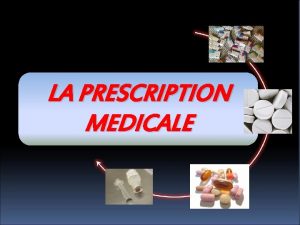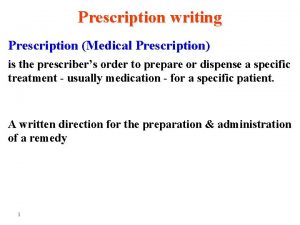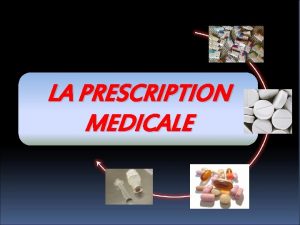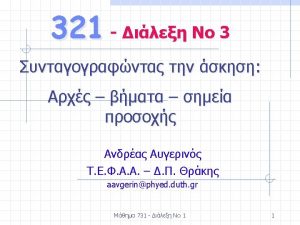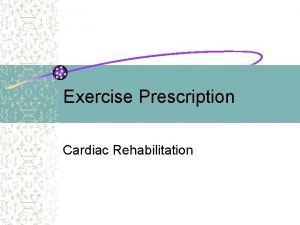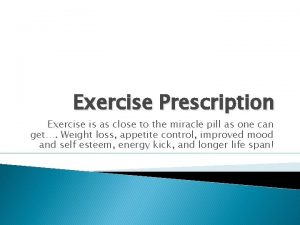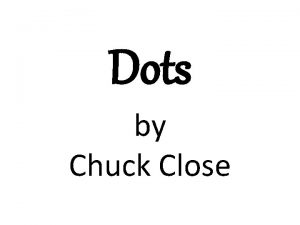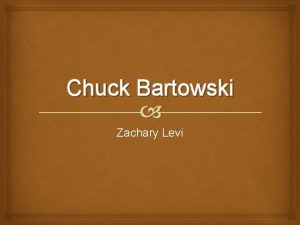EXERCISE PRESCRIPTION FOR CHF Chuck Kitchen MA FAACVPR
















































- Slides: 48

EXERCISE PRESCRIPTION FOR CHF Chuck Kitchen, MA, FAACVPR Chuck. kitchen@gmail. com

CELEBRATION

POSTED 2 -18 -14 �http: //www. cms. gov/medicare-coverage- database/details/nca-decisionmemo. aspx? NCAId=270

NATIONAL COVERAGE DETERMINATION NCD 20: 10 �Effective date: February 18, 2014 CAG # 00437 N �HF patients are not eligible for ICR Evidence of benefit based on CR model, not ICR 4

MEDICARE PROVISION FOR CR Same regulation for HF: 42 CFR 410. 49 � 1 -2 hour sessions/day > 91 minutes=2 sessions < 90 minutes=1 session � Up to 36 sessions per course � Up to 36 weeks to complete CR course � Required components Physician-prescribed exercise (CR team) Cardiac risk factor reduction interventions 5

ELIGIBILITY CRITERIA �CMS criteria were derived from HF- ACTION Trial for patient eligibility. �Research design often differs from “real world” procedure for valid reasons. 6

ELIGIBILITY CRITERIA Beneficiaries with stable, chronic heart failure meeting ALL of following: 1. Left ventricular ejection fraction < 35% 2. NYHA class II-IV symptoms despite being on optimal heart failure therapy for at least 6 weeks 3. Stable=have not had recent (< 6 weeks) or planned (< 6 months) major cardiovascular hospitalizations or procedures 7

ELIGIBILITY CRITERIA Beneficiaries with stable, chronic heart failure meeting all of following: 1. Left ventricular ejection fraction < 35% Measurement by any method is OK EF >35% not eligible ▪ EF not always an exact measurement 8

ELIGIBILITY CRITERIA Beneficiaries with stable, chronic heart failure meeting all of following: 2. NYHA class II-IV symptoms despite being on optimal heart failure therapy for at least 6 weeks Goal for HF patients is not symptom-free, but that patients are able to monitor and control their symptoms Similar to stable angina 9

NYHA CLASSIFICATION

ELIGIBILITY CRITERIA Beneficiaries with stable, chronic heart failure meeting all of following: 3. Stable=have not had recent (< 6 weeks) or planned (< 6 months) major cardiovascular hospitalizations or procedures Hospitalization is not required No per year or per lifetime limit, as with all CR dx 11

ELIGIBILITY CONSIDERATIONS � 30 -day all-cause re-admission penalties for HF dx Role for CR to provide transitional treatment to improve care coordination ▪ Start education earlier post-DC? 12

ELIGIBILITY CONSIDERATIONS �What about patient with AMI who has EF < 35%? �What about patient who would benefit from > 36 sessions? Similarities to stable angina diagnosis Goal is to prepare patient for selfmanagement 13

PREVELENCE OF HEART FAILURE

HOSPITAL DISCHARGE CHF

COST OF CHF

HEART FAILURE � 5. 1 MILLION people have CHF � 825, 000 new cases per year � 279, 000 total mention mortality-2010 � 57, 000 underlying cause 2010 � 1, 084, 000 hospital discharges-2005 �Estimated cost 2005 -34. 8 BILLION

IS EXERCISE SAFE FOR CHF �YES!!! �HF-ACTION TRIAL

HF ACTION STUDY � There was a small reduction in the combined end-point of all cause death or all-cause hospitalization. This was the primary endpoint for the trial and is what is driving some of the media headlines. � There was a modest reduction in the important protocolspecified disease-specific combined end-point of CV death or HF hospitalization. Yes, this ~14% reduction is modest, but please note that this improvement occurred in patients already receiving (on-top-of) excellent evidence-based background therapy…. ~92% were on ACE inhibitors or angiotensin receptor blockers; 95% on beta-blockade; and 40% were enrolled with ICD device already implanted. 19

HF ACTION STUDY � Exercise did not increase the risk for events. � There was a modest improvement in quality of life scores among the patients in the exercise group. � Finally, “Based on the safety of exercise training and the modest reduction in clinical events, the HFACTION study results support a prescribed exercise training program for patients with reduced LV function and HF symptoms in addition to evidencebased therapy. ” Steven Keteyian, Ph. D CEPA website 20

CLINICAL CONSIDERATIONS FOR HF & CR “Cardiac Rehabilitation Exercise and Self-Care for Chronic Heart Failure”. Ades PA, Keteyian SJ, Balady GJ, Houston-Miller N, et al. JACC Heart Fail 2013; 1: 540 -547. Evidence to support Exercise prescription Self-care counseling 21

EXERCISE PRESCRIPTION �Constant Work Rate (CWR) The workload is fixed and remains the same throughout the exercise session Example: Treadmill 3. 0 mph 2% grade for 20 min �Interval Training The workload varies throughout the exercise session. Example: Treadmill 2. 5 mph 2% grade for 5 min increase to 3. 0 mph 3. 5% grade for 5 min, etc 22

EXERCISE PRESCRIPTION �AIT-Aerobic Interval Training �MCT-Moderate Continuous Training �MICE-Moderate Intensity Aerobic Continuous Exercise �HIIE-High Intensity Aerobic Interval Exercise

EXERCISE PRESCRIPTION �Exercise Intensity Domains Assumes the use of CWR method �Light to Moderate �Moderate to High �High to Severe �Severe to Extreme 24

LIGHT TO MODERATE INTENSITY �All work rates with steady state VO 2 below the 1 st VT. �Blood lactate does not elevate above resting levels �Metabolism is aerobic �Generally well tolerated with modest fatigue �Able to maintain for greater than 30 -40 minutes 25

MODERATE TO HIGH INTENSITY �Work rates between 1 st VT and CP �Typically can be sustained for about 30 min 26

HIGH TO SEVERE INTENSITY �All work rates above CP �No steady state is achieved �Blood lactate continually rises �Duration less than 20 minutes �Can only be used for interval training, not continuous 27

SEVERE TO EXTREME INTENSITY �Work rate is so high that fatigue comes before peak VO 2 can be reached �Less than 3 minutes duration �As a result of short duration blood lactate levels not as high as with High to Severe intensity 28

EXERCISE PRESCRIPTION 29

EXERCISE PRESCRIPTION

INTERVAL PRESCRIPTION Intervals-Green Arrows 85 -95% 4 minutes Cool-down Warm-up 60 -70% 3 -5 minutes 8 -10 minutes Active Recovery-Blue 60 -70% 3 minutes 31

AIT VS MCT * * AIT MCT 32

VARIOIUS EXERCISE INTENSITIES �Meta analysis, over 5800 patients �High intensity, vigorous intensity, moderate intensity, low intensity groups �Peak VO 2 increased 23% in High intensity vs control �Vigorous and moderate intensity also showed significant improvement �Low intensity did not show improvement ▪ Ismail H, Mc. Farlane JR, Nojoumian AH, et al. “Clinical Outcomes and Cardiovascular Responses to Different Exercise Training Intensities in Patients with Heart Failure” JACC Heart Fail 2013; 1(6): 515 -522

VARIOUS EXERCISE INTENSITIES Ismail H, Mc. Farlane JR, Nojoumian AH, et al. “Clinical Outcomes and Cardiovascular Responses to Different Exercise Training Intensities in Patients with Heart Failure” JACC Heart Fail 2013; 1(6): 515 -522

VARIOUS EXERCISE INTENSITIES �Higher intensity groups increased VO 2 the most �Higher peak VO 2 equals lower mortality �NO DEATHS with over 123, 000 patient hours of exercise training!! �Higher intensity exercise is safe and effective

WOMEN AND CHF �Women showed similar increases in peak VO 2 as men �However, women had larger decrease in hospitalization and larger reduction in all cause mortality. ▪ Pina IL, Bittner V, Clare RM, et al. “Effects of Exercise Training on Outcomes in Women with Heart Failure: Analysis of HF-ACTION by Sex” JACC Heart Fail Published online February 26, 2014.

EXERCISE PRESCRIPTION �Frequency �Intensity �Time �Type F. I. T. T. PRINCIPLE

EXERCISE PRESCRIPTION FREQUENCY � 3 Days per week initially �Build up to 4 -5 days per week

EXERCISE PRESCRIPTION �RPE Scale �Dyspnea �Heart Rate INTENSITY

EXERCISE PRESCRIPTION 6 7 very, very light 8 9 very light 10 INTENSITY RPE SCALE 11 light 12 13 somewhat hard 14 15 hard 16 17 very hard 18 19 very, very hard 20

EXERCISE PRESCRIPTION INTENSITY DYSPNEA SCALE (Modified Borg) 0 None 5 Severe 0. 5 Very, Very slight 6 1 Very slight 7 Very Severe 2 Slight 8 3 Moderate 9 Very, Very Severe 4 Somewhat severe 10 Maximum

EXERCISE PRESCRIPTION INTENSITY HEART RATE � 40% to 85% of HR reserve method �Start slowly and progress slowly �Progress to 60 to 85% of HR reserve �Beware of failure of HR to rise appropriately! �With increased HR’s use interval training

EXERCISE PRESCRIPTION

EXERCISE PRESCRIPTION TIME �Initially 10 to 20 minutes � 20 to 40 minutes/session �May have to use shorter bouts (2 -6 mins) more frequently with 2 to 4 minute rest periods

EXERCISE PRESCRIPTION TYPE �Aerobic Interval Training

EXERCISE PRESCRIPTION �Exercise Prescription is an Art!! �Every patient is different 46

REFERENCES � Ades PA, Keteyian SJ, Balady GJ, Houston-Miller N, et al. “Cardiac Rehabilitation Exercise and Self-Care for Chronic Heart Failure” JACC Heart Fail 2013; 1(6): 540 -547 � Go AS, Mozaffarian D, Roger VL, et al. “Heart Disease and Stroke Statistics 2014 Update: A Report From the American; Heart Association” Circulation 2014 129: e 28 -e 292 � Ismail H, Mc. Farlane JR, Nojoumian AH, et al. “Clinical Outcomes and Cardiovascular Responses to Different Exercise Training Intensities in Patients with Heart Failure” JACC Heart Fail 2013; 1(6): 515 -522

REFERENCES � Mezzani, A, Hamm, LF, Jones AM, et al. Aerobic Exercise Intensity Assessment and Prescription in Cardiac Rehabilitation: A Joint Position Statement of the European Association for Cardiovascular Prevention and Rehabilitation, The American Association of Cardiovascular and Pulmonary Rehabilitation, and the Canadian Association of Cardiac Rehabilitation. JCRP 2012; 32(6): 327 -350 � O’Connor CM, Whellan DJ, Lee KL, et al. “Efficacy and Safety of Exercise Training in Patients with Chronic Heart Failure: HFACTION Randomized Controlled Trial” JAMA 2009; 301(14): 14391450 � Pina IL, Bittner V, Clare RM, et al. “Effects of Exercise Training on Outcomes in Women with Heart Failure: Analysis of HF-ACTION by Sex” JACC Heart Fail Published online February 26, 2014.
 Chuck kitchen
Chuck kitchen 5200 chf brut en net
5200 chf brut en net Fisinopril
Fisinopril Chf core measures
Chf core measures Chf-v
Chf-v Types of chf
Types of chf Difference between shift and rotate instructions
Difference between shift and rotate instructions Exercise prescription example
Exercise prescription example How to write an exercise prescription
How to write an exercise prescription Principles of therapeutic exercises
Principles of therapeutic exercises Prepositions of place kitchen
Prepositions of place kitchen In the kitchen or at the kitchen grammar
In the kitchen or at the kitchen grammar Chuck mohler cornell
Chuck mohler cornell Network chuck kasm
Network chuck kasm Chuck hauck
Chuck hauck Chuck connell
Chuck connell Chuck grimm
Chuck grimm 3 jaw chuck grasp examples
3 jaw chuck grasp examples Text mining stata
Text mining stata Chuck connell
Chuck connell Lucas by chuck close
Lucas by chuck close Internal audit transformation
Internal audit transformation Cast away chuck noland character analysis
Cast away chuck noland character analysis According to jean piaget children cease to exhibit
According to jean piaget children cease to exhibit Chuck huber stata
Chuck huber stata Chuck close childhood
Chuck close childhood Chuck gillespie
Chuck gillespie Chuck cusack
Chuck cusack Pitot tube bernoulli equation
Pitot tube bernoulli equation Well ordering principle
Well ordering principle Chuck close youtube
Chuck close youtube Bernoulli chuck
Bernoulli chuck Chuck baris
Chuck baris Eqdfa
Eqdfa Chuck humphrey
Chuck humphrey Chuck baird famous paintings
Chuck baird famous paintings Chuck huber stata
Chuck huber stata Chuck eberle
Chuck eberle Julio has fragmented thinking
Julio has fragmented thinking Chuck mueller
Chuck mueller Chuck mohler ithaca
Chuck mohler ithaca Pillar drill bits
Pillar drill bits 3 jaw chuck grasp examples
3 jaw chuck grasp examples The tool used for making internal threads is called as mcq
The tool used for making internal threads is called as mcq Chuck close
Chuck close Photorealism chuck close
Photorealism chuck close Chuck huber stata
Chuck huber stata Chuck tolbert
Chuck tolbert Chuck allison
Chuck allison
